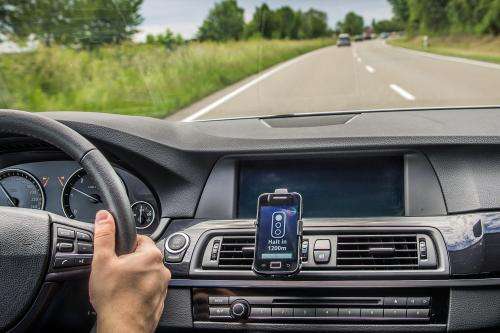Progressive traffic signal systems save time and fuel

In cities, the uniform and low speed levels simplify the setup of synchronized traffic signals. Outside urban areas this is a bigger challenge: The travel speeds vary more and the distances between the traffic lights are often much larger. Researchers at the Technische Universitaet Muenchen, the BMW Group, the TRANSVER GmbH and the Supreme Building Authority in the Bavarian Ministry of the Interior have presented the results of their investigation into how progressive traffic systems can also be set up on arterial roads outside of cities.
As test tracks they selected a section of the federal road B13 in the north of Munich and a section of the state road 2145 near Regensburg. A first major challenge was to integrate the traffic lights on the test tracks, which were up to 20 years old and supplied by different manufacturers, into a unified communications and control structure. From the data obtained in the analysis of traffic flows on these routes, the researchers then developed different control concepts, a fixed-time control and a demand-responsive coordination.
Although the test route in the north of Munich is only five kilometers long, the intelligent traffic light control scheme developed in the project reduces the travel time by about a minute. The best results are achieved by a dynamic, traffic-actuated model. Due to a reduction of stops at signalized intersections, the mean waiting time is reduced from about one minute to seven seconds. An optimized fixed-time control nevertheless still reaches a saving of 30 seconds, thus halving the waiting period. The intelligent control increases the share of intersections that can be passed without stops from about 60 percent to almost 100 percent.
In addition to the intelligent traffic light control, the researchers developed a driver information system. The traffic lights transmit their data via mobile network to the headquarters of TRANSVER GmbH, where a computer processes the data and sends information on signalization to the vehicles. A vehicle's on-board computer or an application on a smart phone indicates whether the vehicle is moving with the appropriate speed in order to reach a green light at the next intersection. The range of possible speed recommendations is shown by means of a "green carpet" on the smartphone's or on-board computer's display. "This is especially helpful when approaching the first traffic light, but also animates to adjust the driving speed," says Michael Krause of the Institute of Ergonomics at the TU Muenchen. "Particular care was also taken to ensure that the additional information does not distract the driver."
Staff and volunteers traveled thousands of kilometers in the simulator and on the test tracks to test the effects of different control options. "Rigid programs allow a very good forecast of traffic signal timings. This is a good foundation for the driver information system," says Dr.-Ing. Alexander Dinkel, project manager at TRANSVER GmbH. "However, a dynamic traffic control takes into account the variability and dynamics of traffic not only in the main direction but also of the cross traffic. Overall, the intelligent approach produces the best results. "
With a trick, the researchers succeeded in combining the advantages of both systems: They defined a core area, symbolized by a green band on the display. Based on the static signal timings it shows the time interval in which a green light will reliably be reached. The dynamics take place only in adjoining areas, allowing the system to respond to different traffic loads on the main track and the cross traffic.
Provided by Technical University Munich



















